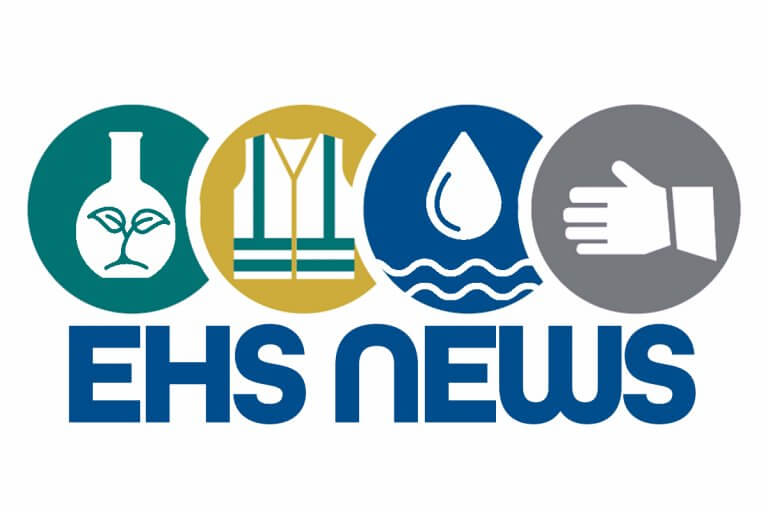
EHS Corner – Noteworthy EHS Regulatory Topics
We have seen an uptick in new and proposed Environmental, Health and Safety (EHS) regulations with the transition of the administration. At Environmental Standards we are closely following many new and proposed regulations.
- Occupational Safety and Health Administration (OSHA) has issued a proposed rule to update the Hazard Communication Standard (Hazcom) – https://www.osha.gov/hazcom/rulemaking
- U.S. Environmental Protection Agency (US EPA) issued Final National Pollutant Discharge Elimination System (NPDES) 2021 Multi-Sector General Permit (MSGP) for stormwater discharges associated with industrial activity – https://www.govinfo.gov/content/pkg/FR-2021-02-19/pdf/2021-03391.pdf
- OSHA published guidance on Return to Work for COVID-19 – https://www.osha.gov/sites/default/files/publications/OSHA4045.pdf
- US EPA adds PFAS/PFOA to its Toxic Release Inventory (TRI) Reporting along with nonylphenol ethoxylates (NPEs) – https://www.epa.gov/toxics-release-inventory-tri-program/addition-certain-pfas-tri-national-defense-authorization-act
- New Jersey Department of Environmental Protection (NJ DEP) has proposed to amend rules to regulate fumigants and fumigation operations based on potential to emit, rather than weight of raw materials – https://www.state.nj.us/dep/rules/proposals/20210301a.pdf
- US EPA Proposes Removing Pentachlorophenol Registration under Federal Insecticide, Fungicide, and Rodenticide Act (FIFRA) – https://www.epa.gov/pesticides/epa-takes-action-protect-public-health-proposing-cancellation-pentachlorophenol#:~:text=After%20completing%20a%20risk%20assessment,(FIFRA)%20registration%20review%20process
- US EPA Delays Updated Lead and Copper Rule Revisions (LCRR) – https://www.regulations.gov/document/EPA-HQ-OW-2017-0300-1836 .
OSHA’s Hazard Communication Standard (HCS) Update:
The Occupational Safety and Health Administration (OSHA) recently proposed a rule to modify the Hazard Communication Standard (HCS), last modified in 2012. The idea behind this rule is to bring the HCS in line the latest revision of the Globally Harmonization System (GHS) and address issues arising since the adoption of the GHS.
The proposed modifications include:
- Revised criteria for classification of certain health and physical hazards,
- Revised provisions for updating labels,
- New labeling provisions for small containers,
- Technical amendments related to the contents of safety data sheets (SDS), and
- Related revisions to definitions of terms used in the standard.
As always, OSHA’s mission is to ensure a safe and healthy work environment by setting and enforcing standards and by providing training, outreach, education, and assistance. OSHA expects the proposed updates to the HCS will do that by providing additional worker protections and reduce the chemical-related incidents by improving communication and labeling of hazards and related information.
The proposed rule would affect establishments in a variety of different industries in which employees are exposed to hazardous chemicals or in which hazardous chemicals are produced. The agency is specifically seeking comment on the proposed rule for purposes such as to analyze feedback from affected industries and address challenges that the new rule may impose on organizations. The comment period closes on April 19, 2021, for employers and manufacturers who wish to comment on the proposed rule.
US EPA’s New NPDES MSGP for Stormwater Discharges
On February 19, 2021, the US EPA issued the final 2021 NPDES Multi-Sector General Permit (MSGP) for stormwater discharges associated with industrial activity. The MSGP covers stormwater discharges from industrial facilities in 30 business sectors in states/territories where US EPA is the NPDES permitting authority including Idaho (until July 1, 2021), Massachusetts, New Hampshire, New Mexico, Indian country lands, Puerto Rico, the District of Columbia, and most U.S. territories and protectorates. While most states have been delegated NPDES permitting authority, Environmental Standards expects to see incorporation of requirements from the MSGP into their own general permits, in particular where there are new or more stringent requirements. Many states also simply reissue the federal permit under their letterhead. The final permit became effective on March 1, 2021.
According to Manko, Gold, Katcher & Fox LLP (an environmental and energy law practice based in Philadelphia, PA)[1], “… many of the proposed changes in the MSGP stem from the settlement of litigation over the 2015 MSGP. The settlement called for a study to be conducted by the National Academy of Sciences, Engineering, and Medicine’s National Research Council (NRC) on changes that could be made to the MSGP. The study suggested changes focused primarily on monitoring requirements for consideration in the 2021 MSGP.”
Some changes included in the 2021 MSGP include the following:
- Quarterly indicator analytical monitoring for pH, total suspended solids (TSS), and chemical oxygen demand (COD); however, no threshold or baseline value is required to be met.
- Biannual indicator monitoring for polycyclic aromatic hydrocarbons (PAHs) for discharges from surfaces sealed with coal-tar sealcoat, and facilities that manufacture, use, or store creosote or creosote-treated wood and some others.
- Additional benchmark monitoring in subsequent permit years. Previously, benchmark monitoring terminated if no exceedances were reported.
- Updated benchmark monitoring values for aluminum, cadmium, copper, and selenium for freshwater discharges to freshwater and removal of benchmark monitoring values for magnesium and iron.
- Additional Implementation Measures (AIM) protocol is required for repeat benchmark exceedances. The AIM involves the implementation of various tiered stormwater controls.
- Additional monitoring for discharges to impaired waters.
Safe Return to Work
With the vaccine rolling out in massive force, many businesses are beginning to think about returning to work. Returning to work in a safe and thoughtful manner is the umbrella under which reopening must occur according to OSHA’s general duty clause (the Act’s General Duty Clause, Section 5(a)(1), requires employers to provide their employees with a workplace free from recognized hazards likely to cause death or serious physical harm).
The COVID-19 pandemic has changed the work environment and the way in which employers conduct business. The virus has presented organizations with many new challenges especially within the health and safety field. Employers are looking for ways to minimize the risk of COVID-19 while keeping up with the demands and deadlines of everyday business. Environmental Standards is helping organizations manage COVID-19 safely and efficiently by providing support for the following COVID-19 items: Exposure Assessments; Exposure Control Plans, Protocol Development; Reopen/Restart Plans; Testing and Management Programs; On-site COVID-19 Oversight; and Facility Auditing.
PFAS, PFOA, and NPE TRI Reporting
As reported by Environmental Standards (https://www.envstd.com/march-2020-1-172-pfas-substances/), per- and polyfluoroalkyl substances (PFAS) have been added to the TRI chemical list and are required to be reported for the first time during this reporting period due on July 1, 2021, for the 2020 reporting year. With lower reporting thresholds, 100 pounds per TRI category, many manufacturers are potentially subject to reporting requirements. PFAS/PFOA compounds joined 13 NPE that were first reportable last year (https://www.envstd.com/chemical-reporting/) for 2019 activity. NPEs can break down in the environment to short-chain NPEs and nonylphenol, both of which are highly toxic to aquatic organisms.
New Jersey – Proposed Regulations – Hazardous Air Pollutants
This rulemaking includes three major components. First, the NJ DEP proposes to regulate fumigants and fumigation operations based on potential to emit, rather than weight of raw materials, to provide clarity on the regulatory requirements for these operations that utilize highly toxic chemicals (fumigation). Second, the NJ DEP proposes to regulate three air contaminants that are not currently regulated by the state, to be referred to as state-specific hazardous air pollutants (New Jersey Hazardous Air Pollutants). Third, the NJ DEP proposes to add 13 air contaminants to the list of “toxic air pollutants” that must be included in an emission statement submitted by a source otherwise subject to emission statement requirements (emission statements). The NJ DEP uses the term “air contaminant” in this rulemaking and in its air pollution control rules to refer generically to substances in the air. The term “air contaminant” is defined throughout N.J.A.C. 7:27 to mean “any substance, other than water or distillates of air, present in the atmosphere as solid particles, liquid particles, vapors or gases.”
This rulemaking also includes proposed penalty provisions at N.J.A.C. 7:27A for the proposed amendments to the Air Pollution Control rules. In addition, the NJ DEP proposes amendments to remove references to the discontinued Facility-Wide Permit Program, as well as miscellaneous amendments throughout the rules to correct grammar and punctuation, and to enhance clarity and readability.
US EPA Proposes Ban of Pentachlorophenol Under FIFRA
After completing a risk assessment, US EPA determined that pentachlorophenol poses significant human health risks to workers. To address this issue, US EPA is proposing to cancel all uses of pentachlorophenol through the Federal Insecticide, Fungicide and Rodenticide Act (FIFRA) registration review process. Pentachlorophenol is a heavy-duty wood preservative used primarily on utility poles.
US EPA’s proposed action would align the United States with the United Nation’s Stockholm Convention on Persistent Organic Pollutants, which has banned the use of pentachlorophenol. US EPA has worked with industry stakeholders to identify a number of viable, safer alternatives such as copper naphthenate and Dichlorooctylisothiazolinone (DCOIT), along with well-established wood preservatives such as chromated arsenicals and creosote.
This proposed interim decision (PID) is the next step in the FIFRA registration review process that US EPA conducts at least every 15 years. After considering any comments concerning the PID, US EPA will issue an interim decision, which would finalize the cancelation of pentachlorophenol.
See our more in-depth discussion of the proposed pentachlorophenol ban in this quarter’s newsletter here:
[1] https://www.mankogold.com/publications-EPA-NPDES-MSGP-Stormwater-Permit-Industrial.html
US EPA Proposed Delay of Lead and Copper Rule Revisions
The US EPA is proposing to delay until December 16, 2021, the effective date of the National Primary Drinking Water Regulations: Lead and Copper Rule Revisions (LCRR), which was published in the Federal Register on January 15, 2021. US EPA is also proposing to delay the January 16, 2024, compliance date established in the LCRR to September 16, 2024. The delay will allow sufficient time for US EPA to complete its review of the rule in accordance with those directives and conduct important consultations with affected parties. The proposed delay in the compliance date of the LCRR ensures that any delay in the effective date will not reduce the time provided for drinking water systems and primacy states to take actions needed to assure compliance with the LCRR. Comments must be received on or before April 12, 2021.
CLICK HERE to read our more in-depth discussion of the LCRR in this quarter’s newsletter.

